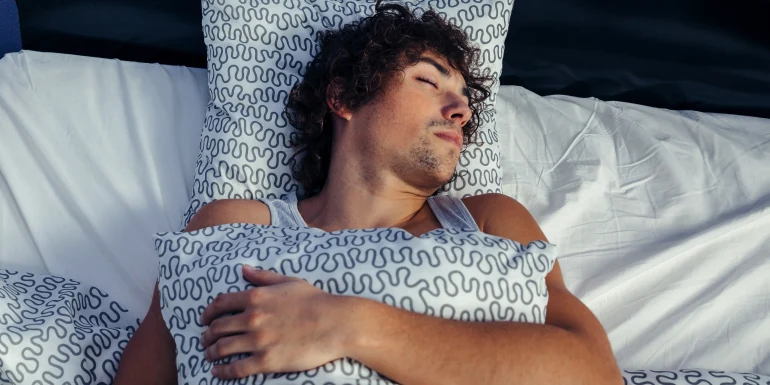
Sleepwalking: possible causes and precaution
Those affected by sleepwalking can sometimes find themselves in strange or even dangerous situations. We show you what exactly it is all about and what you can do.
There is no shortage of strange stories about sleepwalking – from going for walks and cleaning to piano playing. Less readily available, however, is scientific knowledge on these night-time excursions, termed somnambulism in technical jargon. Scientists refer to a sleeping disorder that usually occurs during the deep sleep phase. The following morning, those affected can generally not remember anything about it.
Body awake despite sleep
In most cases, sleepwalking lasts from a few seconds to minutes and primarily takes place in the bedroom. “It is rare for sleepwalking to last longer”, says Daniela Janssen, a psychotherapist and somnologist at the Hirslanden Centre for Sleep Medicine in Zurich. When people sleepwalk, various areas of the brain are activated that put those affected in a special state – a mix of being awake and asleep. In other words, our movement sequences work although our brain is resting.
The trigger for this is a “wake-up disorder” that starts around one hour after falling asleep. The brain activates our motor functions that can be triggered via various stimuli, for example by a loud noise or a full bladder. Our consciousness is switched off while we sleep, meaning sleepwalkers usually do not feel any pain or recognise familiar people.
Children are the primary sleepwalkers
Around 15 to 30 per cent of all children sleepwalk at least once in their life. After reaching the age of ten, the sleeping disorder generally decreases and in most cases ceases by puberty at the latest. The causes of this are not documented. It is highly likely that genetic factors play a role: 80 per cent of those affected have another family member who suffers or suffered from sleepwalking. Stress can also be responsible, for example the stress experienced when starting school or sleeping in an unusual place.
In the cases of adults, sleepwalking can occur independently of other sleeping disorders. It is not unusual for it to be linked to respiratory problems or uncontrolled leg movements in our sleep. Excessive alcohol consumption, a lack of sleep, stress or physical burdens can also give rise to a restless night. “The causes of this phenomenon are completely different”, says Janssen. It is therefore all the more important that adult sleepwalkers see a doctor.
- Lock doors and windows before going to sleep.
- Remove fragile objects and tripping hazards from your bedroom.
- Make sure to get enough sleep – a nap during the day can also help.
- Avoid considerable physical or mental strains.
- Do not have a radio and television in your bedroom.
What to do if you sleepwalk
Sleepwalking can be unpleasant for relatives, especially for partners who sleep in the same bed as sufferers. However, sleepwalkers are only a danger to themselves. The better you know about your nightly activities, the better you can protect yourself accordingly. “Consider what could be dangerous for you during your sleep and take appropriate individual safety measures”, recommends Janssen. Fragile objects or obstacles on the floor, for example, should be cleared away, especially in the bedroom. It is also advisable to close house and balcony doors before going to sleep and to hide the keys.
Dealing with sleepwalkers: don’t wake them – talk
“Only wake them if they are in acute danger”, advises Daniela Janssen, “and do not turn on the light”. What can help: talking. “Suggest to the person that they go back to bed”. The same applies to touching: “Always announce what you are going to do in advance”, emphasises the expert, for example with statements such as “I am going to hold your hand and take you back to bed”.
This will prevent the sleepwalker from being woken up. “If sleepwalkers are woken up, they usually respond in a very confused fashion, sometimes also aggressively”, warns Janssen. For children, certain rituals before falling to sleep can also help: “Read your child a goodnight story every evening so that he or she is better able to get used to the day-night rhythm and relax”.

Daniela Janssen (lic. Phil. somnologist and psychotherapist FSP) is a member of the Specialist Somnology Team at the Zentrum für Schlafmedizin Hirslanden Zürich (centre of somnology). She advises adults, young people and children with sleeping disorders. As a psychotherapist, she also works in her own practice. Daniela Janssen was available to the editorial team in an advisory and editorial capacity for this article.



Newsletter
Find out more about current health issues every month and get all the information you need about our attractive offers from all Helsana Group companies * delivered by e-mail to read whenever it suits you. Our newsletter is free of charge and you can sign up here:
We did not receive your information. Please try again later.
* The Helsana Group comprises Helsana Insurance Company Ltd, Helsana Supplementary Insurances Ltd and Helsana Accidents Ltd.